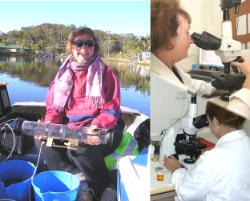Dam nuisance! Algal toxins could be 'lurking near pipes'
Published on 27 November, 2009
It's a dam nuisance but an important lesson for operators of Australian water utilities, who have previously drawn drinking supplies from deep water to avoid algal toxins (cyanobacteria).
Now internationally-recognised research by CQUniversity PhD student* Sally Everson has shown that, while bottom-sourced water may be clear of cyanobacteria blooms, in some cases the toxin can be dissolved throughout the entire water column and concentrated in the bottom 3-4 metres.

Sally Everson in the field and lab
---------------------------------------------------------
Sally's 'day job' is as a Senior Technical Officer at Tweed Shire Council's Tweed Laboratory Centre
and she's a NATA (National Association of Testing Authorities) signatory in both Microbiology and Phycology.
---------------------------------------------------------
Sally's study into toxin distribution in a NSW lake has been published this year in the international Marine and Freshwater Research journal and was presented an an international conference in New Zealand (last year).
She said that, while cyanobacterial blooms can rise and fall in the water column in search of nutrients, they generally appear in the top 3-4 metres of a water body, preferring the warmth and light for photosynthesis and other processes.
"Certain species such as Microcystis and Anabaena produce thick smelly scums that are obvious and a deterrent to both public and animal use. The toxins produced by these species are usually contained within the cells and are expressed as the cells die with degredation occurring naturally," Sally said.
"Traditionally, therefore, off-take pipes in drinking water storage dams are positioned at depth to avoid the highest algal cell concentrations (and any toxin that may be contained within these cells).
"This research project has revealed that other species of cyanobacteria have different properties in regards to the toxins they produce.
"The 2 species Cylindrospermopsis raciborskii and Aphanizomenon ovalisporum were detected in a small 20 metre deep freshwater lake.
"Most of the algal cells as expected were in the top 3-4 metres, however, the toxin was dissolved throughout the entire water column and concentrated in the bottom 3-4 metres!
"There was no visible scum or discolouration and the toxin that these 2 species produce (Cylindrospermopsin) has no taste or odour.
"Therefore, this presents a potential risk for both humans and animals as there were no visible signs present to indicate that the water quality might have been compromised."
Sally said off-take pipes tend to be positioned to avoid the highest algal cell and therefore toxin concentrations ... "but not this toxin!"
"Water guidelines are based on algal cell counts and utility managers react to algal cell concentrations rather than to toxin levels. There are some very good reasons for this, namely that cell counts are easier, quicker and cheaper to do whereas toxicity testing is more time consuming and expensive as well as a scarcity of accredited testing facilities.
"This situation, together with the assumption that the toxin remains within the algal cells, continues to foster the practice of using cell counts for management decisions.
"This management practise reflects not only a gap in the scientific understanding of toxic algal blooms (partly addressed by this research), but also in the practical difficulties of toxicity testing.
"This research suggests that where the algal species Cylindrospermopsis raciborskii and Aphanizomenon ovalisporum are concerned, it would be prudent to understand the toxin profile before determining the off-take depth.
"This new information is extremely important as it seems that many operators of Australian dams have been pumping or releasing deeper water to avoid toxin when in fact they are avoiding the algal cells but not necessarily the toxin!"
Sally said the toxin Cylindrospermopsin is toxic to liver and kidney tissue and inhibits protein synthesis.
"Initial symptoms would include those similar to gastroenteritis and hepatitis including abdominal pain and vomiting. These symptoms are likely to advance to kidney failure and bloody diarrhoea with severe dehydration and death if the concentration of the toxin is sufficiently high," she said.
* Sally's PhD research is supervised by CQUniversity's Associate Professor Larelle Fabbro (principal) and Dr Susan Kinnear (associate), along with Dr Paul Wright from Tweed Lab Centre.

